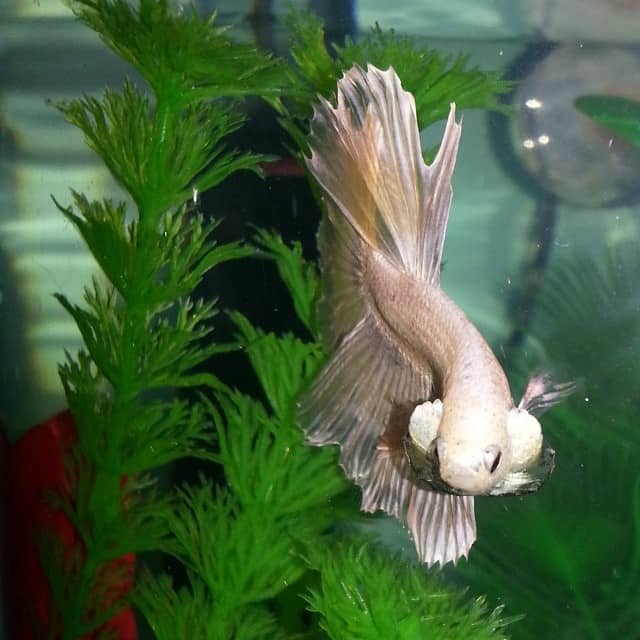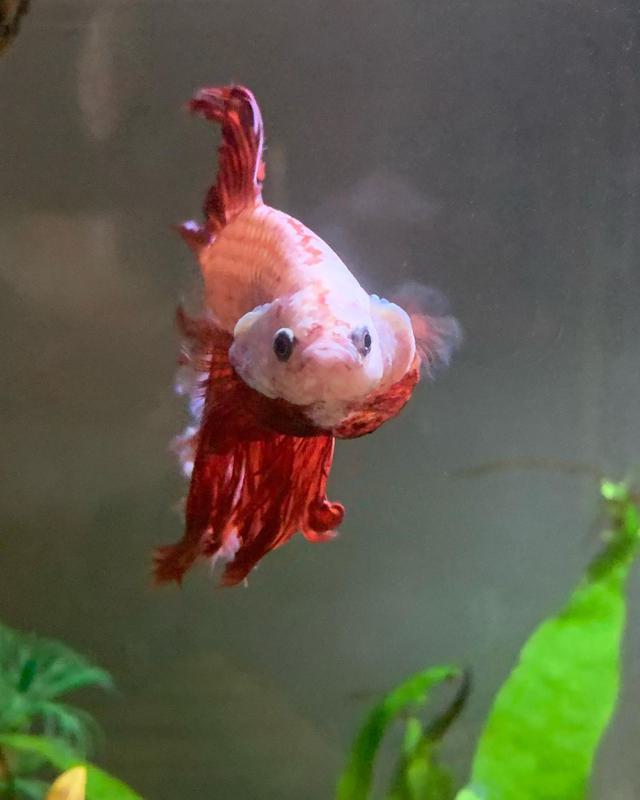Few fish species are arguably as well known in the aquarium hobby as the Betta fish. Also known as Siamese fighting fish, these beautiful creatures display an impeccable array of colors, patterns, and tail forms.
One of their most iconic behaviors is flaring – this is when they puff up their gills to make themselves look bigger. It’s not something terrible. Usually, Betta fish flare as a response to stimuli like impending danger or potential competition.
That said, if you’re looking at getting a Betta for your next aquarium, it’s important to know what this behavior means and why Betta fish flare in the first place. That’s why in this article, we’ll talk about this fascinating phenomenon.
Signs of Betta Flaring

Betta gills flaring and fins opened wide might be a common sight to veterans, but beginners to the hobbies might need to know what to watch out for. Here are the surest signs of flaring in Bettas.
Fanned-out fins
Flaring Bettas extend their fins to their full extent, showing off their majestic fins. The dorsal, caudal, and anal fins will all be spread out to their maximum width and height, creating the impressive display that Bettas, particularly the males of this species, are known for.
They do this to make themselves appear more prominent and to intimidate things they perceive as threats. We’ll discuss this more below.
Expanded Gill Covers
Betta flaring involves the fish puffing up its gill covers, reinforcing its intimidating appearance. This display can make the Betta appear larger, in addition to the extended fins.
This is one of the more worrying displays that might shock beginner hobbyists when they first witness it – but don’t worry, it’s completely normal.
Aggressive Body Posture
Flaring Bettas adopt a confrontational posture, positioning their bodies directly toward the perceived threat.
You can notice this quickly as they fixate on their perceived threats and face them slightly angled sideways. Your fishes do this to display their larger physique and establish dominance.
This aggressive stance highlights the Betta’s territorial nature and readiness to defend its territory. In fact, male Bettas in the wild will typically circle each other in this way before commencing a fight.
Reasons for Betta Flaring

Now that you know what to look out for, it’s time to understand what’s causing your Betta fish to flare in the first place. Knowing what’s causing your pet to react is essential so that you can evaluate whether it’s a normal reaction or something is causing them distress.
Territorial Behavior
The most common reason that Bettas flare is their innate territorial nature. In the wild, Betta fish usually hunt in their own territories.
Naturally, they have an instinct to defend their territory. They will flare at other Bettas or even similar fish to ward them off before they could even do anything.
If your Betta is housed in a small aquarium of 10 gallons or below, then they’ll automatically take possession of the entire space as their territory. For tanks larger than 10 gallons, they may pick a specific spot and claim it as theirs.
Anything they perceive to violate said territory will be taken as a threat and therefore flared at.
Perceived Threat
Even outside their territories, Betta males can still be susceptible to other things in their tanks that they can consider threats.
Specifically, they tend to flare when they see another fish in the tank, particularly if those fish are long-finned like them. This is because Bettas don’t have long memory spans or a comprehensive understanding of threats, so they have no choice but to rely on visual cues.
One of these cues is long fins. Since many Betta males are long-finned, Bettas will automatically assume that anything with long fins is another male Betta – triggering their natural territorial instinct. This is why keeping long-finned fish is a no-no in a Betta tank.
This is also the reason for the infamous mirror reflection flares, where Bettas may put on an aggressive display when they see their reflection in the glass of the tank.
Stress Response
Betta fishes can be exceptionally grouchy when stressed – which is why it’s important to be mindful of what causes them to become stressed in the first place.
For example, while tank cleaning might not be a big deal to you, it can be pretty scary for a small animal like your Betta. Cleaning and rearranging their tank while they’re inside may trigger their aggression and make them flare or even try to attack your hand when you’re in there.
In other words, if your Betta fish flares too often, it might be a stress reaction. It could be a sign that they’re not doing well and that you might need to do something to make them feel better.
Stretching
Like humans and many other animals, Betta fishes might simply flare their fins to stretch them out.
You can distinguish a simple stretch from a stress response when they aren’t fixated on a specific location and not displaying any other acts of aggression (circling like they would at other male Bettas).
At the end of the day, stretching their fins is very typical and even healthy for Bettas.
How to Minimize Betta Stress

Betta fish gills flaring may be typical, but excessive flaring can be a sign that there’s something stressing your Betta out. Luckily, prevention is better than cure.
Here are some tips to help you avoid stressing your Betta out, therefore preventing them from flaring too much.
- Create a cozy habitat: Providing a well-structured and spacious tank is the foundation of any aquarium, specifically for a curious Betta. Bettas appreciate plants, caves, and peaceful surroundings that mimic their natural environment, making them feel secure and less exposed.
- Maintain stable water parameters: Fluctuating water conditions can stress out your fish friends and cause them to be excessively aggressive. Regularly test and maintain proper water temperature (around 78-80°F), pH, and ammonia levels. Use a reliable filter to ensure water quality.
- Avoid overcrowding: Overcrowding can lead to territorial disputes and stress, as Bettas will stake their claim on one part of the tank and fight with anyone getting near it. Be mindful of how much space you have in your tank and only house the appropriate number.
- Don’t surprise them with big changes: If you were a fish, you would also find it pretty stressful if a big hand from the sky started rearranging your house. Keep redecorations simple and subtle. If you need significant changes, it’s best to take your fish to a temporary holding tank and reintroduce him to the new environment.
- Limit flaring triggers: Reduce activities that provoke flaring, such as showing a mirror, placing them near other males, and excessive interaction with your fish.
Follow these tips to ensure you’re not unduly stressing out your Betta fish. While it’s normal for them to flare out, it’s not an ideal state for them and is best done very seldom.
Read More:
FAQs
Why Is My Betta Fish Flaring Its Gills at Me?
Betta fish might consider foreign objects and stressors threats, which triggers their fight-or-flight response. When you see a Betta fish gills out and flaring when you approach, it’s likely because they haven’t acclimated to your presence yet, and your presence still spooks it out. Give your pet time to adjust.
Why Does My Betta Fish Puff out His Gills at Me?
Puffing out its gills is a sign that your presence threatens them. This often happens when they’re not used to you yet. Luckily, your Betta just needs time to adjust to their new environment and sights.
Do Female Bettas Flare?
Female Bettas do flare, although it’s not as often or even as magnificent of a spectacle. This is because female Bettas have shorter fins in general. Nevertheless, they still flare for the same reasons, such as aggression or stress.
Why Is My Betta Flaring at Nothing?
If you see your Betta flaring at nothing, they’re probably just stretching their fins. Like humans, when they stretch their limbs, fish also have an instinct to simply spread occasionally. This is normal behavior and nothing to worry about.
Conclusion
Betta fish flaring gills and fins are a magnificent sight, and it’s one of the main reasons many fishkeepers get Bettas instead of other species. Very little in the hobby can match the elegance and splendor of a healthy Betta male fully flexing itself.
If you want to be a responsible Betta owner, it’s essential to understand this phenomenon and what it could represent. And now that you’ve reached the end of the article, you know this is a natural reaction but could signify something worse if it happens excessively.
With this knowledge, you can design a safe and cozy environment for your Betta fish that won’t stress out.